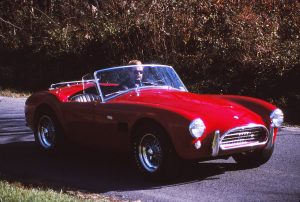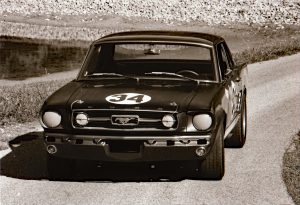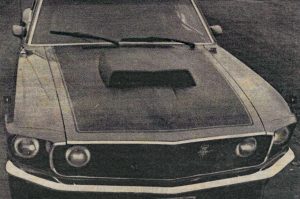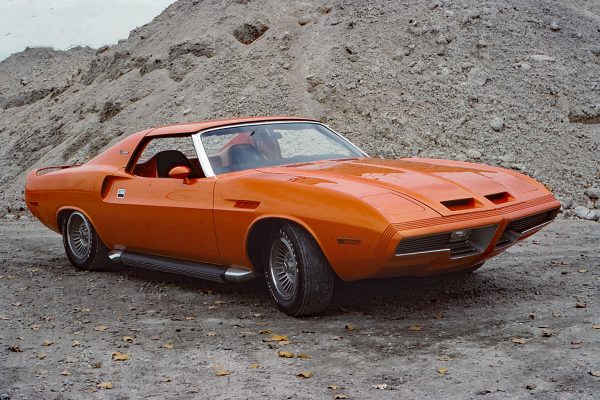Car review originally published in CarBuzzard May 21, 2016
There’s a sort of chicane, and the 2016 Shelby GT350R Mustang tags the curbing on the right and then the left and then there’s a straight ahead. Put the hammer down. There’s a slight rise so the next corner can’t be seen, but it’s a left and the braking points are marked with cones. The revs build quickly, the distinctive growl of the flat-plane crank V-8 pitch rises as the tachometer’s needle swings past 6500, 7000, 7500 and on towards the 8200 rpm redline. Orange-red dots flash on the base of the windshield, moving pincer-like, the HUD saying it’s time to shift.
Into fourth. The lever slides as if by magnet from third to fourth. Revs drop. Back on the throttle. The speedometer is academic. Braking point. Stand on the Brembos. The GT350R sheds kinetic energy and would stop dead before the turn-in point if the brakes weren’t released.
Giggle.
Heel-and-toe down into third. Hit the apex oh-too-slow and then back on the power. There are apexes yet to be hit.
We’re at Pocono International Raceway, not on the tri-oval that NASCAR uses but rather an infield course, one of a number that can be configured, for the North American Track Tour for the 2016 Ford Shelby GT350 Mustang and Shelby GT350R Mustang. Our track time is limited. We have to share. But it only a handful of laps to discover that it’s one of the best street-legal track-ready—or is it track-ready street-legal—cars we’ve ever driven.
Thank the current cold war with hot cars—as the Camaro Dodge Challenger Hellcat, Camaro Z/28 (next generation caught testing—and crashing—at Nurburgring), BMW M4—and the 2016 Ford Shelby GT350 Mustang. Ford unleashed Ford Performance to release not just a can of whoopass but a whole case on the trackable ‘Stang.
Here, at length but still not everything, is what they did. The Mustang is a worthy platform to exploit for the new GT350, well balanced, good basic aerodynamics and finally a independent rear suspension system. Into this went a high-performance flat-plane crankshaft 5.2-liter V-8. The flat-plane crank—where the crank throws are all 180 degrees apart instead of at 90 degrees—yields an even firing order, which means even pulses in intake and exhaust and better breathing at high rpm. The arrangement of the crank throws also means the crank counterweights can be smaller and lighter, allowing quicker revving and because of less mass moving around, an engine that can wind out further. Max revs for the GT350’s engine? Redline is 8200 rpm, and it will stay there all day.
The lighter crank throws also allows lighter pistons and connecting rods, and vice versa. The pistons are forged aluminum and have reduced tension piston rings for reduced drag. The connecting rods are forged steel with cracked caps, stronger and lighter than conventional connecting rods and caps. Again, higher revs.
The 5.2-liter V-8 just isn’t bigger for bigger’s sake. The cylinder heads are all new, CNC-machined, with the ports optimized using computational fluid dynamics. The GT350 engine’s bigger bore means there’s room for bigger valves, and to get the most out of bigger valves they had to be relocated outwards, so the valves are not only bigger, they’re at a different angle. Extra weight was also machined off the head where it wasn’t needed.
Weight came off the other end of the engine as well with a single-piece integrated oil pan, with the windage tray, oil pickup and baffle all one piece. It can hold about two quarts more oil but is 20 percent lighter.
Ford Performance engineers chased weight everywhere. One obvious place was in the suspension and brakes. While retaining conventional ventilated and cross-drilled cast iron brake discs, the discs were mounted on an aluminum center via pins to reduce heat transfer that would eventually get to the wheel bearings during enthusiastic track use. (Discs are positioned over the hubs and pins inserted from the inside).
Ford Performance could have specified ceramic brake discs for the ultimate in weight savings—those huge iron Frisbees are heavy—but servicing is very expensive, too costly for someone with an earthbound budget, the kind of owner the Mustang would attract. The discs themselves are huge, 15.5 inches in front and 15.0 inches at the rear. Big? Think in terms of your last pizza.
Ford went outside for brake calipers with Brembo binders at both ends, six-piston fixed calipers with integrated caliper stiffening bridges, and at the rear the Shelby GT350 makes do with four-piston calipers.
More weight was saved in the suspension with aluminum, including the front steering knuckle (which had to be changed from stock anyway to clear the big Brembo calipers) and the lower control arm at the rear. Changing the parts also allowed changing the suspension geometry to take advantage of the larger wheels and tires.
They are not necessarily lighter—in fact we suspect they may add slightly to weight overall—but the 2016 Ford Shelby GT350 Mustang is the first Ford to utilize MagneRide shock absorbers. The shocks, developed by Delphi and used for years by an American manufacturer which often goes by two letters one of which immediately follows F in the alphabet and the other comes just before N, allow almost instantaneous variation of damping firmness. MagneRide suspension uses data from sensors to electronically change the viscosity of shock absorber fluid in ten milliseconds, which is fast enough for anything you might do.
The 2016 Ford Shelby GT350 Mustang gets extra-stiff 19-inch wheels, 10.5 inches wide in front, 11.0 inches at the rear. Ford has worked with Michelin in the past, so Michelin Pilot Super Sport tires with specially-developed sidewall construction, tread face and compound go on the GT350 .
Ford saved more weight in the placement of supplemental coolers, the transmission cooler in one cheek scoop and the engine oil cooler in the other, as part of the optional Track Pack. The radiator for the rear differential cooling system was moved to the rear of the car, saving the weight of the hoses (and the coolant in them) running forward, while shifting the weight of the radiator to the rear. A special diffuser sucks air from under the car, through the radiator and out the rear fascia of the car.
There are subtle and not so subtle changes to the exterior. The wider wheels and front track of the Shelby GT350 required wider fenders, made from aluminum. The hood was lowered for aerodynamics by as much as two inches, with a vent to allow heated air under the hood to escape as well as reduce lift be reducing air pressure under the hood. Panels were added under the car to direct airflow to reduce lift. Front fender vents and vented inner fenders remove turbulent air in the wheel wells and guide it along the side of the car. The lightweight grille leans forward but has specific openings for the radiator, high-pressure engine air intake and cooling ducts for the front brakes.
Changes to the interior are not as obvious, but Recaro competition bucket seats are a no cost option to the big-bolster Ford sport seats that work on the track but are more comfortable to use in everyday driving. Ford Performance designers eliminated or reduced bright accents that might distract the driver or cause glare. The flat-bottomed steering wheel is de rigueur, of course, but it also houses a button to change driving modes which include normal, sport and track, plus drag, rain and individual settings for the various elements.
And then there’s the 2016 Ford Shelby GT350R. The big “R” stands for “race” or “rapid” or “oh my goodness is this even more fun.” What it means is Ford Performance took even more weight out of the Mustang GT350, removing the back seat, air conditioner, the stereo system, trunk floorboard and carpet, backup camera and emergency tire sealer and inflator. The exhaust resonators are gone too, for lighter weight, of course, and it sounds neat too. [Insert smiling devil emoji here.]
However, GT350R buyers can walk that back a bit with an Electronics Package, which includes a dual-zone air conditioning, 8-inch touch screen with navigation, seven-speaker audio system, turn signal mirrors and more. One needn’t give up everything to get the GT350R’s better bits.
To wit, the even better aerodynamic bits include a more aggressive splitter up front. But track testing proved that the front aerodynamics worked so well that the rear end was getting loose at high speeds, so Ford Performance solved that with the large rear wing. And wing it is, an inverted airfoil like an airplane’s wing fitted upside down.
Perhaps the most exotic—if there’s a space for that word in this checklist—element of the GT350R, at least compared to the standard GT350, are the carbon fiber wheels. At 19×11-inch front and 19×11.5-inch rear, the wheels save about 16 pounds each compared to an equivalent aluminum wheels. At 18 pounds, one of the carbon fiber weighs a little more than two gallon jugs of milk. That helps not only by reducing the overall weight of the vehicle but also improves handling by reducing unsprung weight, and acceleration and braking by reducing rotational inertia by more than 40 percent which, per Ford Performance, “positively impacts acceleration and braking performance.”
There won’t be many 2016 Shelby GT350 and GT350R Mustangs produced. There’s no “limited edition” number set, though past experience suggests that only about 5,000 will be made per year. It’s good we won’t have permanent custody of one because then we’d have to find a way to sneak into Pocono International and see how late we could brake, how hard we could go around corners and hear that flat-plane 5.2-liter V-8 rev out to 8200 rpm. Alas we were just getting started when it was time to stop. We wanted more.
2016 Ford Shelby GT350R Mustang, price and key specifications as tested
Body style/layout: 5-door crossover wagon, front engine/all-wheel drive
Base price: $61,295
Electronics package: $3,000
Delivery: $900
Price as tested: $65,195
Engine
- Type: 5.2-liter 32-valve DOHC V-8
- Displacement, cc: 5163
- Block/head material: aluminum/aluminum
- Compression ratio: 12.0:1
- Horsepower: 526 @ 7500 rpm
- Torque: 429 @ 4750 rpm
- Recommended fuel: premium unleaded
- Fuel economy, EPA est.: 14/2 city/highway
- Fuel economy, observed: n.a.
Transmission:6-speed manual
Chassis/Suspension
- Suspension, Double-ball-joint MacPherson strut / Integral-link independent
- Wheels: 19 x 11.0 / 19 x 11.5-inch alloy
- Tires, front/rear: 305/30ZR19 / 315/30ZR19; Michelin Pilot Sport Cup 2
- Brakes: 4-wheel disc; 15.5-inch dia. front/15.0-inch dia. rear
- Steering: electric power rack-and-pinion
- Turning circle: 40.4 ft.
Dimensions
- Wheelbase: 107.1 in.
- Length: 189.7 in.
- Height: 53.6 in.
- Width: 75.9 in.
- Curb weight: 3,655 lbs
- Trunk volume: 13.5 cu. ft.
- Fuel tank: 16.0 gal.
Safety
- Airbags: Front, driver knee, glovebox, side curtain
- Anti-lock brakes: Yes Traction control: Yes Stability control: Yes Electronic brake-force distribution: Yes Brake assist: Yes
- Other:
Warranty: 3-year/36,000 mile bumper-to-bumper; 5-year/60,000 mile powertrain;5-year/unlimited-mile corrosion

















What Do You Think?
You must be logged in to post a comment.